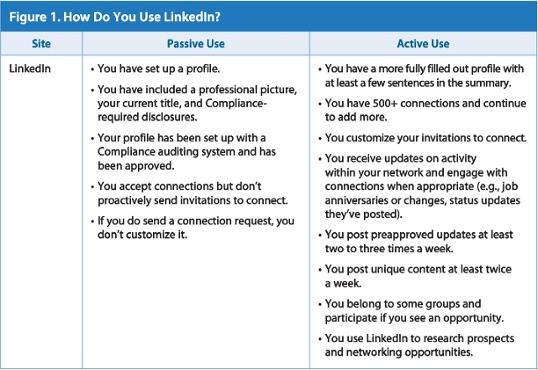Why You Should Be Active on Social Media
by Commonwealth Financial Network
 A 2015 survey reveals that 81 percent of financial advisors use social media for business purposes. When I first saw that stat, I thought, “It’s amazing that 81 percent of advisors use social media!” As I thought more about it, though, I started to question what use means.
A 2015 survey reveals that 81 percent of financial advisors use social media for business purposes. When I first saw that stat, I thought, “It’s amazing that 81 percent of advisors use social media!” As I thought more about it, though, I started to question what use means.
The definition is important because if you can be active on social media (i.e., actually use it), you can reap its many benefits:
- Better search engine rankings on your name or practice name
- More visibility
- Increased brand awareness
- Less expensive prospecting
- Broadened networking capabilities
- Easier and broader content distribution
- Perception of credibility and trustworthiness based on demonstrated expertise and thought leadership
But these benefits won’t be realized if you don’t have a clear understanding of what it means to actively use social media.
There are two types of social media users:
Passive users would answer “yes” if asked whether they use social media. In reality, however, they have simply set up a social media profile or two but don’t post updates.
Active users have carefully considered how social media fits into their marketing strategy. They have created full profiles, post original content, and proactively engage with those who follow or are connected to them.
So, where do you fit?

Given the benefits outlined above, you may see the appeal of being an active social media user. Still, you might be reluctant to go all in. Why? Here are a few reasons I’ve heard and how I typically respond.
You say: I’m not interested in social media, and my clients and prospects aren’t either. We like face-to-face conversations. Social media’s for kids.
I say: I’m not suggesting you should replace face-to-face interactions, but instead supplement your in-person meetings with virtual interactions. The fact is, many of your peers are interested in social media. According to a March 2016 post on Hootsuite, 71 percent of American adults with access to the Internet use Facebook, and 79 percent of those users are between the ages of 30 and 49.
You say: I’m getting requests from people I went to grade school with. It’s a waste of time getting to know them again.
I say: Before you delete those requests, think about whether some of those people could be in your target market. What about their parents or children? Check out their profiles, and see where they live and what they do for a living. Maybe it wouldn’t be such a bad idea to accept that request and follow up with a personal message or e-mail. At some point, they’ll probably ask what you do for work. We’ve definitely heard success stories that evolved in exactly this way.
You say: Writing is a struggle for me.
I say: You don’t have to be a good writer to see social media success. You can share relevant articles that someone else has written and simply add a sentence or two about why you chose that content. Your comments might just resonate with your target market.
You say: I don’t have time.
I say: Set aside just a few minutes a week to start. Keep in mind that these sites are designed so that novice users can quickly become experts. Here are some tips to help:
- Focus on one site based on your top goals. All sites can help with search engine rankings, but some sites are better than others for specific goals. For instance, LinkedIn is best for networking and prospecting, Facebook for relationship building, and Twitter for thought leadership.
- Experiment to figure out the best times to post and what’s effective. When is your target market most likely to check social media? If they work full-time, try early morning, lunchtime, and later in the evening. If they are retired, try midmorning first. To determine which types of posts get the most engagement, try posting some updates with pictures and some without. Pose questions, throw in a survey, profile people in your practice, or highlight your giving back efforts. Then, observe what gets the most engagement. You can go by gut instinct or rely on analytics.
- Share the responsibilities. Although much of social media is about personal branding and transparency, some aspects can be shared with your staff. For example:
- Ask everyone in the office to come up with one or two status updates each week.
- Have brainstorming sessions to generate less time-sensitive ideas.
- Ask your clients if you can connect with them on LinkedIn in order to build up connections and followers. Staff members could also ask clients if they use Facebook and would become fans of your Facebook company page.
You say: I don’t know what to post.
I say: As I mentioned, you can share the responsibilities for brainstorming ideas or finding interesting topics to post about. You can also share articles you already read by using the social media icons attached to those articles (like the ones found below). Once you click on the icon, you simply need to type in a few words of your own and hit a button.
Another great way to find articles of interest is to set up a Twitter account and check your feed once or twice a day. You don’t need to tweet just because you have a Twitter account. Start by subscribing to experts in areas that would be interesting to your clients and prospects. For instance, if you’re targeting employees at a particular company, follow some of its executives. If you’re trying to connect with your clients’ children, follow thought leaders who might post about juggling career and family. Don’t limit yourself to posting only about financial topics.
It’s time to stop making excuses and make a commitment. Start small—just 15 minutes a week for four weeks. Once you make the switch from passive to active user, I’m confident that you’ll become a success story. And who knows? I bet you’ll even have some fun along the way.
Do you consider yourself to be an active user on social media? How do you measure engagement with content you've posted? Please share your thoughts with us below!
Commonwealth Financial Network is the nation’s largest privately held independent broker/dealer-RIA. This post originally appeared on Commonwealth Independent Advisor, the firm’s corporate blog.
Copyright © Commonwealth Financial Network

















